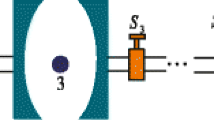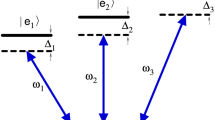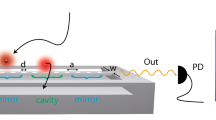Abstract
We present an experimentally feasible method, based on currently available cavity QED technology, to generate n-partite linear cluster and graph states in external degree of freedom of atoms. The scheme is based on first tagging n two-level atoms with the respective cavity fields in momentum space. Later on an effective Ising interaction between such tagged atoms, realized through consecutive resonant and dispersive interactions of auxiliary atoms with the remanent cavity fields, can generate the desired atomic momenta states. The procedure is completed when the auxiliary atoms after passing through Ramsey zones are detected in either of their internal states. We also briefly explain the generation of weighted graph states in the atomic external degree of freedom.
Similar content being viewed by others
References
Schrödinger E.: Die gegenwärtige Situation in der Quantenmechanik. Naturwissenschaften 23, 807–812 (1935)
Translation, Proc. Am. Philos. Soc. 124, 323–338 (1980)
Schrödinger E.: Probability relations between separated systems. Naturwissenschaften 32, 446–452 (1936)
Einstein A., Podolsky B., Rosen N.: Can quantum-mechanical description of physical reality be considered complete?. Phys. Rev. 47, 777–780 (1935)
Bohr N.: Can quantum-mechanical description of physical reality be considered complete?. Phys. Rev. 48, 696–702 (1935)
Bell J.S.: On the Einstein Podolsky Rosen paradox. Physics 1, 195–200 (1964)
Aspect A., Dalibard J., Roger G.: Experimental test of Bell’s inequalities using time-varying analyzers. Phys. Rev. Lett. 49, 1804–1807 (1982)
Ekert A., Jozsa R.: Quantum computation and Shor’s factoring algorithm. Rev. Mod. Phys. 68, 733–753 (1996)
Gisin N., Ribordy G., Tittel W., Zbinden H.: Quantum cryptography. Rev. Mod. Phys. 74, 145–195 (2002)
Galindo A., Martin-Delgado M.A.: Information and computation: classical and quantum aspects. Rev. Mod. Phys. 74, 347–432 (2002)
For an overview, see, R. Islam: Engineering entanglement in cavity quantum electrodynamincal systems, Ph.D. Thesis, LAP Lambert Academic Publishing, AG&Co. KG, Germany (2010)
Khalique A., Saif F.: Engineering entanglement between external degrees of freedom of atoms via Bragg scattering. Phys. Lett. A 314, 37–43 (2003)
Dürr S., Nonn T., Rempe G.: Origin of quantum-mechanical complementarity probed by a ‘which-way’ experiment in an atom interferometer. Nature (London) 395, 33–37 (1998)
Islam R., Ikram M., Saif F.: Engineering maximally entangled N-photon NOON field states using atom interferometer based on Bragg regime cavity QED. J. Phys. B 40, 1359–1368 (2007)
Islam R., Khosa A.H., Saif F.: Generation of Bell, NOON and W states via atom interferometry. J. Phys. B 41, 035505 (2008)
Khan A.A., Zubairy M.S.: Quantum logic gate operating on atomic scattering by standing wave field in Bragg regime. Fortschr. Phys. 46, 417–422 (1998)
Qamar S., Zhu S.-Y., Zubairy M.S.: Teleportation of an atomic momentum state. Phys. Rev. A 67, 042318 (2003)
Islam R., Ikram M., Ahmed R., Khosa A.H., Saif F.: Atomic state teleportation: from internal to external degrees of freedom. J. Mod. Opt. 56, 875–880 (2009)
Khosa A.H., Ikram M., Zubairy M.S.: Measurement of entangled states via atomic beam deflection in Bragg’s regime. Phys. Rev. A 70, 052312 (2004)
Khosa A.H., Zubairy M.S.: Quantum-state measurement of two-mode entangled field-state in a high-Q cavity. Phys. Rev. A 72, 42106 (2005)
Khosa A.H., Zubairy M.S.: Measurement of Wigner function via atomic beam deflection in the Raman-Nath regime. J. Phys. B At. Mol. Opt. Phys. 39, 5079–5089 (2006)
Hein M., Eisert J., Briegel H.-J.: Multiparty entanglement in graph states. Phys. Rev. A 69, 062311 (2004)
Islam R., Khosa A.H., Lee H.-W., Saif F.: Generation of field cluster states through collective operation of cavity QED disentanglement eraser. Eur. Phys. J. D 48, 271–277 (2008)
Briegel H.-J., Raussendorf R.: Persistent entanglement in arrays of interacting particles. Phys. Rev. Lett. 86, 910–913 (2001)
Raussendorf R., Briegel H.J.: A one-way quantum computer. Phys. Rev. Lett. 86, 5188–5191 (2001)
Nielsen M.A.: Cluster-state quantum computation. Rep. Math. Phys. 57, 147–161 (2006)
Walther P., Resch K.J., Rudolph T., Schenck E., Weinfurter H., Vedral V., Aspelmeyer M., Zeilinger A.: Experimental one way quantum computing. Nature 434, 169–176 (2005)
Dür W., Briegel H.-J.: Stability of macroscopic entanglement under decoherence. Phys. Rev. Lett. 92, 180403 (2004)
Scarani V., Acin A., Schenck E., Aspelmeyer M.: Nonlocality of cluster states of qubits. Phys. Rev. A 71, 042325 (2005)
Walther P., Aspelmeyer M., Resch K.J., Zeilinger A.: Experimental violation of a cluster state Bell inequality. Phys. Rev. Lett. 95, 020403 (2005)
Browne D.E., Rudolph T.: Resource-efficient linear optical quantum computation. Phys. Rev. Lett. 95, 010501 (2005)
Tokunaga, Y. , Yamamoto, T., Koashi, M., Imoto, N.: Simple experimental scheme of preparing a four-photon entangled state for the teleportation-based realization of a linear optical controlled-NOT gate. Phys. Rev. A 71, (R)030301 (2005)
Vallone G., Pomarico E., De Martini F., Mataloni P.: One-way quantum computation with two-photon multiqubit cluster states. Phys. Rev. A 78, 042335 (2008)
Tokunaga Y., Kuwashiro S., Yamamoto T., Koashi M., Imoto N.: Generation of high-fidelity four-photon cluster state and quantum-domain demonstration of one-way quantum computing. Phys. Rev. Lett. 100, 210501 (2008)
Gao W.-B., Yao X.-C., Xu P., Lu H., Guhne O., Cabello A., Lu C.-Y., Yang T., Chen Z.-B., Pan J.-W.: Bell inequality tests of four-photon six-qubit graph states. Phys. Rev. A 82, 042334 (2010)
Cho J., Lee H.W.: Generation of atomic cluster states through the cavity input-output process. Phys. Rev. Lett. 95, 160501 (2005)
Dong P., Xue Z.Y., Yang M., Cao Z.L.: Generation of cluster states. Phys. Rev. A 73, 033818 (2006)
Zhang X.L., Gao K.L., Feng M.: Efficient and high-fidelity generation of atomic cluster states with cavity QED and linear optics. Phys. Rev. A 75, 034308 (2007)
Lee J., Park J., Lee S.M., Lee H.-W., Khosa A.H.: Scalable cavity-QED-based scheme of generating entanglement of atoms and of cavity fields. Phys. Rev. A 77, 032327 (2008)
Li G., Ke S., Ficek Z.: Generation of pure continuous-variable entangled cluster states of four separate atomic ensembles in a ring cavity. Phys. Rev. A 79, 033827 (2009)
Gonta D., Radtke T., Fritzsche S.: Generation of two-dimensional cluster states by using high-finesse bimodal cavities. Phys. Rev. A 79, 062319 (2009)
Ballester D., Cho J., Kim M.S.: Generation of graph-state streams. Phys. Rev. A 83, 010302(R) (2011)
Barrett S.D., Kok P.: Efficient high-fidelity quantum computation using matter qubits and linear optics. Phys. Rev. A 71, 060310(R) (2005)
Duan L.M., Raussendorf R.: Efficient quantum computation with probabilistic quantum gates. Phys. Rev. Lett. 95, 080503 (2005)
Chen Q., Cheng J., Wang K.L., Du J.: Efficient construction of two-dimensional cluster states with probabilistic quantum gates. Phys. Rev. A 73, 012303 (2006)
Tanamoto T., Liu Y.X., Fujita S., Hu X., Nori F.: Measurement-based teleportation along quantum spin chains. Phys. Rev. Lett. 97, 230501 (2006)
Xue Z.Y., Zhang G., Dong P., Yi Y.M., Cao Z.L.: Quantum controlled phase gate and cluster states generation via two superconducting quantum interference devices in a cavity. Eur. Phys. J. B 52, 333–336 (2006)
Zhang X.L., Gao K.L., Feng M.: Preparation of cluster states and W states with superconducting quantum-interference-device qubits in cavity QED. Phys. Rev. A 74, 024303 (2006)
Zheng S.B.: Generation of cluster states in ion-trap systems. Phys. Rev. A 73, 065802 (2006)
Blythe P.J., Varcoe B.T.H.: A cavity-QED scheme for cluster-state quantum computing using crossed atomic beams. New J. Phys. 8, 231 (2006)
Kiesel N., Schmid C., Weber U., Tóth G., Gühne O., Ursin R., Weinfurter H.: Experimental analysis of a four-qubit photon cluster state. Phys. Rev. Lett. 95, 210502 (2005)
Zhang A.-N., Lu C.-Y., Zhou X.-Q., Chen Y.-A., Zhao Z., Yang T., Pan J.-W.: Experimental construction of optical multiqubit cluster states from Bell states. Phys. Rev. A 73, 022330 (2006)
For a theoretical treatment of Bragg regime cavity QED, see, for example, Cook, R.J., Bernhardt, A.F.: Deflection of atoms by a resonant standing electromagnetic wave. Phys. Rev. A 18, 2533–2537 (1978)
Bernhardt A.F., Shore B.W.: Coherent atomic deflection by resonant standing waves. Phys. Rev. A 23, 1290–1301 (1981)
Giltner D.M., McGowan R.W., Lee S.A.: Theoretical and experimental study of the Bragg scattering of atoms from a standing light wave. Phys. Rev. A 52, 3966–3972 (1995)
Dürr S., Rempe G.: Acceptance angle for Bragg reflection of atoms from a standing light wave. Phys. Rev. A 59, 1495–1499 (1999)
Khan A.A., Zubairy M.S.: Quantum non-demolition measurement of Fock states via atomic scattering in Bragg regime. Phys. Lett. A 254, 301–306 (1999)
Scully M.O., Zubairy M.S.: Quantum Optics. Cambridge University Press, Cambridge (1997)
Zubairy M.S., Agarwal G.S., Scully M.O.: Quantum disentanglement eraser: a cavity QED implementation. Phys. Rev. A 70, 012316 (2004)
Rauschenbeutel A., Nogues G., Osnaghi S., Bertet P., Brune M., Raimond J.M., Haroche S.: Coherent operation of a tunable quantum phase gate in cavity QED. Phys. Rev. Lett. 83, 5166–5169 (1999)
Hein, M., Dür, W., Eisert, J., Raussendorf, R., van den Nest, M., Briegel, H.-J.: Entanglement in graph states and its applications, e-print quant-ph/0602096
Kunze S., Dürr S., Rempe G.: Bragg scattering of slow atoms from a standing light wave. Europhys. Lett. 34, 343–348 (1996)
Kunze S., Dürr S., Dieckmann K., Elbs M., Ernst U., Hardell A., Wolf S., Rempe G.: Standing wave diffraction with a beam of slow atoms. J. Mod. Opt. 44, 1863–1881 (1997)
Keller C., Schmiedmayer J., Zeilinger A., Nonn T., Dürr S., Rempe G.: Adiabatic following in standing-wave diffraction of atoms. Appl. Phys. B 69, 303–309 (1999)
Rauschenbeutel A., Bertet P., Osnaghi S., Nogues G., Brune M., Raimond J.M., Haroche S.: Controlled entanglement of two field modes in a cavity quantum electrodynamics experiment. Phys. Rev. A 64, 050301(R) (2001)
Dur S., Nonn T., Rempe G.: Origin of quantum-mechanical complementarity probed by a ‘which-way’ experiment in an atom interferometer. Nature 395, 33–37 (1998)
Fortier K.M., Kim S.Y., Gibbons M.J., Admadi P., Chapman M.S.: Deterministic loading of individual atoms to a high-finesse optical cavity. Phys. Rev. Lett. 98, 233601 (2007)
Ball P.: Quantum all the way. Nature 453, 22–25 (2008)
Rempe G., Schmidt-Kaler F., Walther H.: Observation of sub-Poissonian photon statistics in a micromaser. Phys. Rev. Lett. 64, 2783–2786 (1990)
Gerry C.C.: Proposal for a mesoscopic cavity QED realization of the Greenberger-Horne-Zeilinger state. Phys. Rev. A 54, R2529–2532 (1996)
Deleglise S., Dotsenko I., Sayrin C., Bernu J., Brune M., Raimond J.-M., Haroche S.: Reconstruction of non-classical cavity field states with snapshots of their decoherence. Nature 455, 510–514 (2008)
For a recent review, please see, Cronin, A.D., Schmiedmayer, J., Pritchard, D.E.: Optics and interferometry with atoms and molecules. Rev. Mod. Phys. 81, 1051–1129 (2009)
Raimond J.M., Brune M., Haroche S.: Manipulating quantum entanglement with atoms and photons in a cavity. Rev. Mod. Phys. 73, 565–582 (2001)
Kokorowski D.A., Cronin A.D., Roberts T.D., Pritchard D.E.: From single- to multiple-photon decoherence in an atom interferometer. Phys. Rev. Lett. 86, 2191–2195 (2001)
Uys H., Perreault J.D., Cronin A.D.: Matter-wave decoherence due to a gas environment in an atom interferometer. Phys. Rev. Lett. 95, 150403 (2005)
Jansen M.A.H.M., Domen K.F.E.M., Beijerinck H.C.W., van Leeuwen K.A.H.: Off-resonance atomic Bragg scattering. Phys. Rev. A 76, 053629 (2007)
Author information
Authors and Affiliations
Corresponding author
Rights and permissions
About this article
Cite this article
Islam, Ru., Khosa, A.H., Saif, F. et al. Generation of atomic momentum cluster and graph states via cavity QED. Quantum Inf Process 12, 129–148 (2013). https://doi.org/10.1007/s11128-012-0359-x
Received:
Accepted:
Published:
Issue Date:
DOI: https://doi.org/10.1007/s11128-012-0359-x




